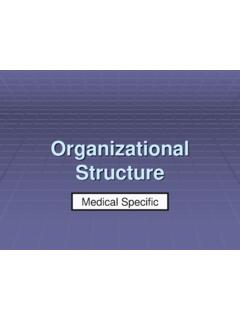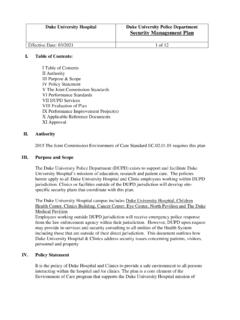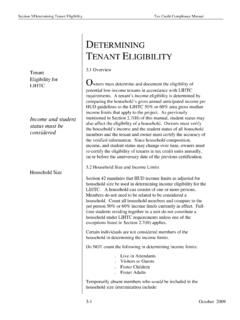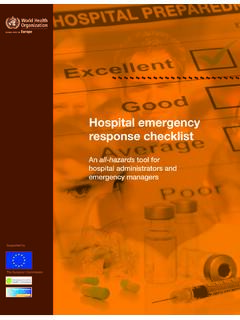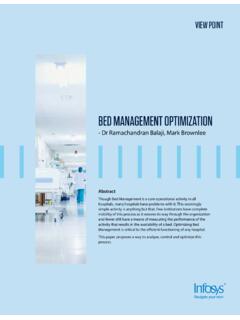Transcription of Determining Patient Days for Summary Data Collection ...
1 Determining Patient days for Summary data Collection : observation vs. Inpatients In response to questions regarding how to count Patient days for observation patients , the following guidance is offered. The NHSN instructions for recording the number of patients in an inpatient unit state that for each day of the month selected, at the same time each day, the number of patients on the unit should be recorded. This procedure should be followed regardless of the Patient s status as an observation Patient or an inpatient . 1. observation patients in observation locations: An o bservation location ( , 24-hour observation area) is considered an outpatient unit, so time spent in this type of unit does not ever contribute to any inpatient counts ( , Patient days , device days , admissions).
2 Admissions to such outpatient units represent encounters for the purposes of outpatient surveillance for LabID Event monitoring in the MDRO/CDI module. 2. observation patients in inpatient locations: a. If an observation Patient is transferred from an observation location and admitted to an inpatient location, then only Patient days beginning with the date of admission to the inpatient location are to be included in Patient day counts (for the location or facility-wide inpatient ). In this same way, device days accrue beginning when the Patient arrives in any location where device-associated surveillance is occurring and in accordance with the location s device-count methods.
3 B. If an observation Patient is sent to an inpatient location for monitoring, the Patient should be included for all Patient and device day counts. The facility assignment of the Patient as an observation Patient or an inpatient has no bearing in this instance for counting purposes, since the Patient is being housed, monitored, and cared for in an inpatient location. Below is an example of attributing Patient days to a Patient admitted to an inpatient location, regardless of whether the facility considers the Patient an observation Patient or an inpatient . The examples show counts taken at: A) 12:00 am and B) 11:00 pm. A. Count at 12:00 am (midnight): Date Mr X Pt Day Mr Y Pt Day 01/01 Mr X admitted at 8:00 am Mr X not counted because the count for 01/01/10 was taken at 12:00 am on 01/01/10 and he was not yet admitted X Mr Y admitted at 12:00 am Mr Y is counted because the count for 01/01 was taken at 12:00 am and that s when he was admitted 1 01/02 1 2 01/03 2 3 01/04 3 4 01/05 Mr X discharged at 5:00 pm 4 Counted for 01/05 because he was in the hospital at 12:00 am on 01/05 when the count for that day was taken Mr Y discharged at 12:01 am 5 Counted for 1/05 because he was in the hospital at 12.
4 00 am on 1/05 when the count for that day was taken Total 4 Patient days 5 Patient days If we use the same admission dates and times for Mr X, but a different time is selected for the Patient day count, say 11:00 pm, the total number of days in the count will be the same; they will simply be coming from different dates. B. Count at 11:00 pm: Date Mr X Pt Day 01/01 Mr X admitted at 8:00 am 1 Counted because the count for 01/01 is taken at 11:00 pm on 01/01 and he is in hospital at that time 01/02 2 01/03 3 01/04 4 01/05 Mr X discharged at 5:00 pm X Not counted for 01/05 because he was not in the hospital at 11:00 pm on 01/05 when the count for that day was taken Total 4 Patient days Determining Admission Counts for Summary data Collection : In response to questions regarding how to count number of admissions, the following guidance is offered.
5 We understand that there are a variety of ways in which Patient day and admission counts are obtained for a facility and for specific locations. We offer this guidance to assist with standardization within and across facilities. It is most important that whatever method is utilized, it should be used each and every month for consistency of data and metrics. How you operationalize this guidance will depend on how you are obtaining the data for your counts. If you are calculating admission counts by hand or are utilizing electronic Patient data to do your calculations by hand, then admission counts should be calculated at the same time each day, as is the method for counting Patient days in NHSN.
6 We suggest that calculating Patient day and admission counts concurrently may be the easiest and most efficient method. This will provide consistency and will eliminate questions about inclusion for individuals who are only present in the facility or in a specific location for a very brief period of time, since there is no minimum number of hours the Patient must be present before being counted. Any Patient who meets criteria for new inclusion should be counted, regardless of whether they are coded by the facility as an inpatient or as an observation Patient . If admissions are calculated electronically for you, then you must check those data to be sure that all appropriate patients are included or excluded from those counts and that your electronic data are within +/- 5% of the number obtained if doing the calculations manually.
7 If these counts are more than 5% discrepant, then you will need to evaluate and discuss with your IT staff to determine the cause of the discrepancies and methods to address them. Large numbers of brief admissions and patients placed in inpatient locations under observation status could be contributing to identified discrepancies. The main goal is to accurately count patients in the denominators that are at risk for potentially contributing to the numerator. 1. Facility-Wide inpatient Admission Count: Include any new patients that are assigned to a bed in any inpatient location within the facility at the time of the facility-wide admission count.
8 Qualification as a new Patient means that the Patient was not present on the previous calendar day at the time of the Patient day count. The daily admission counts are summed at the end of the calendar month for a monthly facility-wide inpatient admission count. 2. inpatient Location-Specific Admission Count: Include any new patients that are assigned to a bed in the specific inpatient location at the time of the location-specific admission count. Qualification as a new Patient means that the Patient was not present on the previous calendar day at the time of the Patient day count. The daily admission counts are summed at the end of the calendar month for a monthly inpatient location-specific admission count.
9 Below is an example of manually counting location-specific and facility-wide admission counts related to a Patient admitted to an inpatient location and transferred to multiple Patient locations during his hospital stay. The example shows counts taken at 11:00 pm. Example: Counts at 11:00 pm: Unit Date/Time Mr. X Placed on inpatient Unit Date/Time Mr. X Transferred Out of inpatient Unit inpatient Location-S pecific Admission Count inpatient Facility-Wide Admission Count SICU 10/08 10:00am (facility admission) 10/13 9:00am 1 Adm for SICU 1 Adm for FacWideIN MICU 10/13 9:15am 10/13 11:00am Not present and so not counted Same Adm, and also not present so not counted Surgical Ward 10/13 11:30am 10/25 1:00pm 1 Adm for Surgical Ward Same Adm so not counted Rehab 10/25 1:30pm 10/26 10:00am (facility discharge) 1 Adm for Rehab Same Adm so not counted










